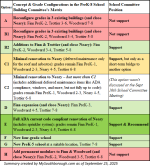Above: Two recent presentations honed in on more analysis of results from the the school building survey this summer. Plus, the School Committee has already voted its position on potential future building scenarios based on an assessment of the educational impacts. (images from presentations and meeting materials)
Town and school officials have continued their work to determine next steps for dealing with school building issues in the wake of voters rejecting the project to replace Neary School with a new 4-grade school.
Since I last updated readers. . .
The committee charged with pulling together costs and data on scenarios for dealing with Southborough’s school buildings has essentially ruled out some of the options they were asked to consider, but added others. They will present their final report to the Select Board in less than two weeks. And the School Committee has already weighed in with its position.
Meanwhile, the School Committee voted to table its planned Fall Town Meeting Article asking for over $4M to replace Neary School’s roof. Instead, they are investing $100K in steps towards the replacement, with a plan to ask voters to fund the bigger project this spring.
In addition to those updates, I have info on additional analysis and highlights that have been presented on results from the Neary Building Project/School Buildings survey conducted this summer.
To make it easier to follow, I’m breaking out those topics below.
Neary School Roof
As I previously reported, the School Committee had agreed that Neary School’s “failing” roof needs to be replaced next summer. They sought to include a Warrant Article on the October 27th Special Town Meeting Warrant to borrow up to $4.25M for the work.
Given uncertainty about the building’s future, it was sure to be controversial. The Select Board had planned to ask the School Committee to attend their October 7th Meeting to answer questions.
At the committee’s September 10th meeting, their plans changed. The NSBORO administration presented an alternative option. Instead of pursuing the funding now, the committee could approve funding of a Feasibility Study without going to Town Meeting.
That would allow them to make progress on the project while postponing making the ask. That does run the risk that a replacement project (even if approved at Annual Town Meeting) would begin late and not be completed by the start of the next school year.
Committee Chair Chelsea Malinowski preferred that approach. She said she worried that questions about how accurate the estimates are for the work could cause a Fall Article to fail.
Members agreed with the plan to have better information to bring voters and more timely estimates. They also hoped the Town would have more information on its longer term plans for the school building by then. (And the roof may have played a role in which of the building scenarios the NSBORO administration is recommending.)
The committee approved spending $100K from facility rental revolving account for the study.
PreK-8 School Building Committee Progress
The Select Board voted recently to extend the charge of the PreK-8 School Building Committee, one final time. The extension from the end of this month to mid-October allows the committee to make its report to the Select Board on October 7th. The committee can also quickly follow up on any cleanup work that comes out of that discussion.
The committee was charged with pulling together a “matrix” showing the costs and relevant details on a list of potential scenarios for housing grades PreK-8. That included using existing buildings, renovating buildings, or building new schools. They were also given the authority to add options to research.
Two designated members have been working with the NSBORO Schools administration on a “heat map” aligned with the matrix to detail the “Educational considerations analysis” for each of the options in the committee’s matrix.
As I previously covered, an early version of the heat map was criticized as including too many assessments that appeared to be based only on the administrations’ subjective opinions. (For instance, whether or not age grouping of students on buses would be appropriate.)
Since then, the group revamped the spreadsheet. Member Kelly Conklin described it as less subjective. They also pulled together backup details to explain assessments that list some scenarios as not maintaining the district’s educational standards.
Based on the elimination of some scenarios, along with discussions among members and public feedback, the committee also added rows to its matrix. (One of those appeared to be less about the committee believing it was a viable options, than about putting together data to show the community why they wouldn’t be.) They also recently split out an option for the Minimal Renovation for Neary (Option C), after realizing that prior Advisory Committee materials showed costs for two different levels of those repairs.
While the committee’s matrix is still incomplete, the School Committee already voted on its positions (and recommendation) options. I’ve included those in the table I put together below describing the options being studied. (The center column is my description of the details and differences between the options based on discussions in the meetings):

(For more details on the School Committee’s votes shown above, scroll down.)
The committee is still working to chase down and better verify some figures and details in the matrix. They hope to be able to complete their work when the meet this Monday, September 30th.
It’s unclear just yet if the committee will unanimously support a final version. At the committee’s August 26th meeting, member Mark Davis passionately disagreed with some decisions about what to detail in the matrix. He appeared to be concerned that projects may appear more viable on paper than he believed them to be.
Davis voiced concern that without identifying where additions could fit at Finn the figures behind estimated costs would be inaccurate. He also argued that plans for additions should include a transition plan — vehemently arguing that young students couldn’t attend school while construction was in progress.1
Chair Beth Wittcoff argued that those concerns were outside of the committee’s charge. Some other members agreed with her that the issues weren’t meant to be addressed by their committee. Those details were ones that the Select Board, School Committee, a future building committee, and possibly a contractor/Feasibility Study.
The argument escalated after Witcoff shut down Davis’ comments to focus on moving forward. Davis angrily left the meeting, claiming that the Chair/committee clearly didn’t have interest in hearing his opinions.
Tim Fling, the Select Board’s representative on the committee acknowledged that Davis had some good points. But he indicated he believed it was sufficient to note under the column for key issues the uncertainties and concerns that need more research.
Fling was also working to further vet and refine construction estimates. But he also stressed that figures were less about accurate estimates and more about comparing the likely financial scale of various options.
Davis did attend the following meeting, where I didn’t catch any further arguments between members.
School Committee Positions
At the September 10th School Committee meeting, the NSBORO leadership team presented its positions on the matrix, based on their educational standards assessment. The team also specified that the option they recommended was “E” to fully renovate and bring Neary up to code.
That option would keep all four PreK-8 schools operational. It’s a big switch given the emphasis the administration made during Neary Building Project presentations about the importance of reducing the number of “transitions” for elementary school students.
Vice Chair Roger Challen questioned the team’s decision to endorse a plan that would keep four school buildings. Challen had served on the School Committee during the time when a representative served on the School Research Committee2 that originally looked into consolidating schools, and also served on the Neary School Building Committee that came out of that.
Challen said he hadn’t “talked to one parent that wasn’t in favor of reducing transitions.” Martineau responded that a lot of parents that they spoke to “were pleased” with the current configuration, and “having less transitions was not something that got them out to vote.”
Upon questioning, Asst. Superintendent Stefanie Reinhorn clarified that parents have told them it’s not a top priority. Martineau followed that they were recommending an option that they could support that they believe the Town could support.
Prior to the meeting, the committee was provided with the administration’s educational analysis “heat map” detailing their assessments for each scenario. You can read that version (dated as of September 5th) here.
The administration’s plan to replace Neary’s roof wasn’t cited as a factor for their recommendation. But, the biggest public criticism for the roof funding request has been the concept of borrowing millions to pay for long term improvements to a building that the Town may decide to close within the next 5 years. That complaint would be moot if the Town chooses to invest in fixing and keeping the building.
The committee voted 4-0 to support the administration’s positions.
School Building Survey Analysis
This summer, the Town and Schools posted results from a community survey seeking to learn what residents and voters thought about the Neary Building Project, what votes they cast (or didn’t) and why, and their opinions and priorities for how to move forward.
As I previously covered, Select Board member Al Hamilton (who had publicly opposed the Neary Building Project) quickly put together his highlights from the survey results, which he presented to the board. Those results were a big factor in the board’s decision to not request an extension to continue pursuing the Neary Building project.
Since then, there have been two more public presentations on analysis of the survey results.
Hamilton collaborated with resident Michael Nute to share more highlights from their analysis of the results from over 700 respondents (and data from the Town census). They made a presentation to the PreK-8 School Building Committee.
And Matt Probst, Chair of the Municipal Technology Committee, worked with School Committee member Laura Kaufman to summarize data. He presented his report and analysis with highlights to the Select Board last week.
Nute’s and Hamilton’s presentation highlighted that when he broke down the results by age group he found only slight differences both in their priorities for new schools and their opinion on options that were included in the survey.
Less surprising was a divisive difference in how urgent the need for a school building project is. (The presentation noted earlier that the respondent’s had a strong correlation with the number and age of young school aged children they did/didn’t have.)
The presentation emphasized:
respondents want a good school option for the town but are deeply concerned about how much it will cost.
You can read Hamilton’s and Nute’s presentation here. [Editor’s Note: The presentation included the interesting detail that 40% of survey respondents reported household incomes over $200K. But in the analysis for residents over the age of 50, have to call out an assumption that I believe oversimplifies income as “wealth”.3
Hamilton and Nute’s presentation included a note that “free responses show a clear mix of confusion and outright distrust.”
That’s a theme that was also heavily stressed in Probst’s report.
In addition to analysis, Probst’s report included recommendations for a future project. He stated the need for the Town to counter “misinformation” and dispel “misconceptions”. That was a theme that public commenter Katie Barry objected to.
Barry believed that residents’ differing opinions from project proponents and concerns about some uncertainties were mischaracterized as “misinformation”.
Probst’s analysis honed in on details from 707 respondents. (That was after data was cleaned up for the 789 submissions.) Upon questioning, he confirmed to the board that it was the highest response the MTC has had for a Town survey.
You can read the report here, plus the graphs and key findings that were presented to the board below:
In both survey discussions, Hamilton stressed the need for any future project to garner support not just from voters with young kids who will be directly impacted, but the rest of the community.
Update (9/26/2025 11:26 am): I had incorrectly written that Roger Challen served on the School Research Committee. I had mistakenly recalled it having two members from the School Committee. But it was only Keturah Marten.
- Chair Beth Wittcoff and member Howard Anderson disagreed that it was certain the Town would rule out an addition while students were at the school. They pointed to the Algonquin renovation that took place with students on campus, although neither had agreed with the decision.
- In Fall 2020, the NSBORO administration and School Committee agreed to collaborate with the Town on researching the ability to close a school. At the time, the Town was seeking to save long term costs. But the school administration and School Committee expressed their interest as finding a way to eliminate one of the young students’ school transitions.
- Obviously, residents over the age of 50 include seniors who are struggling to make ends meet on fixed incomes. But it would also include residents who accumulated big nest eggs before they fully/partially retired. So, income alone may not be the best wealth metric.













